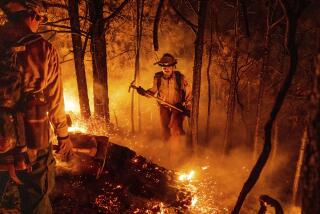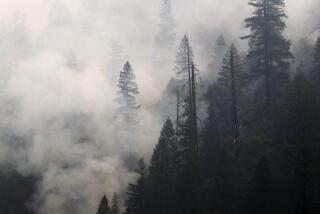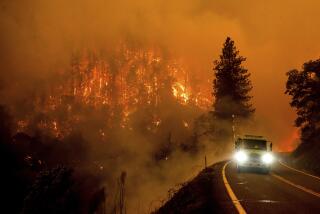Caldor fire threatens more towns as California blazes destroy more than 1 million acres

Before California has even entered peak fire season, the state has already passed a grim milestone: more than 1 million acres burned.
A dozen large wildfires — including the monstrous Dixie fire and the destructive Caldor fire — as well as numerous smaller ones continue to char the landscape and turn thousands of residents into refugees.
Several fires remain at minimal containment days and even weeks after igniting, spurred by hot, dry conditions that have parched vegetation and primed it to burn — often at rapid speed. After igniting more than a month ago, the massive, multicounty Dixie fire was only 35% contained Thursday morning.
New fires seem to crop up almost daily. A pair of blazes — the Cache fire in Lake County and the French fire in Kern County — both erupted Wednesday, forcing swift evacuations. The Cache fire had burned 83 acres and was at least 30% contained Thursday evening, while the French fire had swelled to 3,223 acres with no containment, fire officials said.
Officials in Clearlake said crews were still working to battle the Cache fire, which has destroyed 56 structures and 158 vehicles but so far has not resulted in any fatalities.
The fast-spreading blaze forced authorities to focus first on evacuating residents, including students and staff at Lower Lake High School and Lower Lake Elementary School.
Images of the Caldor fire and the Dixie fire, driven in part by warming temperatures and worsening drought.
Officials said they planned to ask the Clearlake City Council to approve a local emergency declaration, which would help bring in needed resources for the fire recovery process.
Several other wildfires are also ravaging Northern California, including the Monument and McFarland fires, which are burning northwest of the Dixie fire and were sparked in late July by lightning.
Now burning into its fifth day, the Caldor fire in El Dorado County had surged to 68,630 acres by Thursday evening and remained 0% contained as firefighters working with limited resources struggled to create containment lines in rugged terrain.
With winds expected to arrive from the southwest, there are fears the fire burning east of Sacramento could push north on Thursday, threatening the communities of Kyburz, Pollock Pines and Sly Park, fire officials said. Firefighters are stationed in those areas to defend structures.
“That has been the main focus — critical infrastructure and structures — to protect those things with the resources we’ve had on-site,” said Capt. Keith Wade, a public information officer for the California Department of Forestry and Fire Protection’s Incident Management Team 6.
California faces unprecedented dangers as record heat, dryness combine with fierce winds
The Caldor fire exploded Monday afternoon, ballooning from less than 2,000 acres to more than 50,000 two days later, and leveling Grizzly Flats and nearby communities, according to fire officials.
More than 5,000 people in the fire’s path have had to flee their homes. The blaze has already consumed a church, a school and other structures and injured at least two people.
“We know that there was significant damage in those areas,” Wade said.
A damage assessment team that arrived Wednesday was going house to house to tally the destruction and could have an update by Friday, Wade said.
As the blaze continues to spread, crews battling the conflagration have more than doubled, from 250 to just over 650.
Resources have been stretched thin by multiple fires raging across the state. And it’s a constant challenge to determine where to place firefighters, especially in remote areas, Wade said.
“There’s a lot of operational decisions that need to go into play as we attack these large-scale fires,” he said Thursday. “Where to focus our firefight: Do we take it head-on, or do you determine that it’s best to fight from the air, or do you take more of a defensive stance in certain places?”
The Dixie fire — the second-largest wildfire in California history — had seared more than 678,000 acres by Thursday as containment has inched up in recent days.
It continues to threaten several communities, and on Thursday morning, flames were close to Janesville, according to the latest incident report.
The second-largest California wildfire has burned more than 500,000 acres. See the remains through the smoke and ash.
Winds that have spurred red flag warnings across Northern California for several days are expected to die down. Though fire officials said the weather change could offer some respite, they warned that challenging conditions remain.
“We’ll still expect activity just because the dry air that’s around us, the dry fuels and the receptiveness of everything,” fire behavior analyst Brian Newman said during a briefing Thursday morning. “It’s allowing that fire to keep going over there and keep challenging lines.”
Times staff writer Gregory Yee contributed to this report.
More to Read
Start your day right
Sign up for Essential California for news, features and recommendations from the L.A. Times and beyond in your inbox six days a week.
You may occasionally receive promotional content from the Los Angeles Times.










